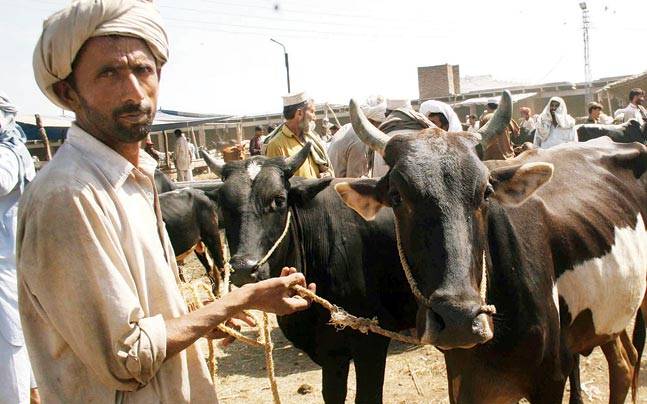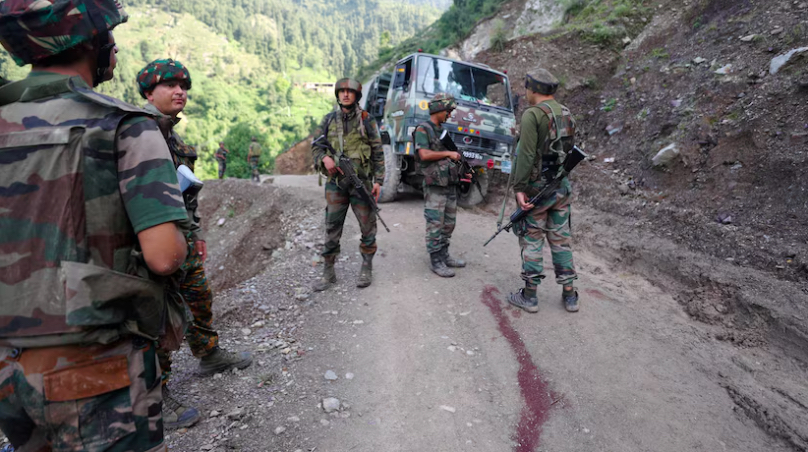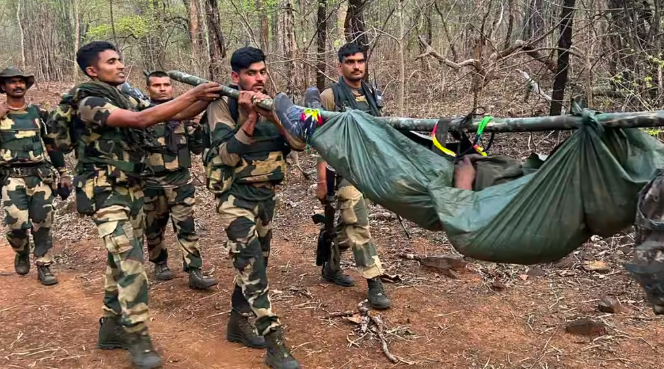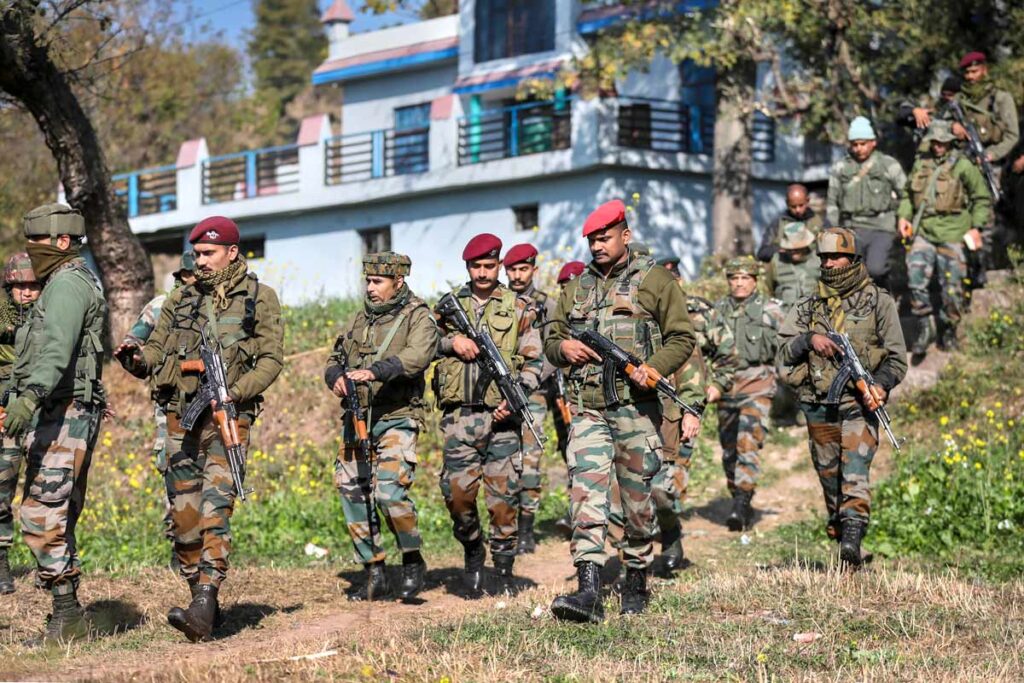MANTRAYA ANALYSIS#35: 19 MARCH 2019
PALLAVI BANERJEE
Abstract
According to a 2016 estimate, 3000 cows are smuggled across the Indo-Bangladesh border each day. It is a trade that is estimated to be worth US$500 million. Since the BJP government came to power in New Delhi, it has taken steps to stop the trade and has claimed to have reduced it by 99 percent. However, a look at the cattle markets in Bangladesh indicates that innovative efforts by organized criminal grows keep the trade going. Is legalising the trade a solution?

(Representational Picture, Source: India Today)
The Trade
The US$500 million worth cattle trade between India and Bangladesh is mostly illegal. The Bharatiya Janata Party (BJP)-led government in New Delhi has declared its intention to stop it. However, the demand for meat in Bangladesh and the hide for the country’s leather industries keeps the trade running. Moreover, the unofficial ban on cow slaughter in many Indian states could be adding to availability of cattle for smuggling into Bangladesh. Notwithstanding the efforts of the border guarding forces, the trade goes on almost in full public spectacle and knowledge.
The Nexus
Cattle traverse hundreds of kilometres from states like Rajasthan, Haryana, Punjab, Uttar Pradesh, Bihar, and Jharkhand to reach the Bangladeshi cattle markets, called the ‘khattals’. They are transported in trucks to their border destinations in West Bengal and Assam.Chillies are stuffed into the eyes of the animals to keep them standing and save space on the trucks in which they are transported. From these border points, smugglers use either the porous land route or the water ways through the rivers Kalindi, Ichhamati, Raimangal and Hariabhanga of Bangladesh to finallyenter the country. In the remote villages, the cattle are bound to one another by iron chains and at night young ‘Rakhals’ or local swimmers, herd the cattle in the water. The remuneration received by the ‘Rakhals’ is close to three thousand Indian rupees for every journey made.[1]
There have also been instances of secret tunnels dug up, by the miscreants, between Bangladesh and India. Such an event came to light upon interrogating two cattle thieves, Samsul Islam and Atabur Rahman, who had been caught while attacking the police force on the Indian side of the border. They confessed that the route taken by them to enter India was through a secret tunnel with one end located at Karimganj, India. The man-made tunnel uses fitted drain pipes and to stay hidden, the cover of the dense forest.[2] Apart from these innovative ways of trafficking the animal, may smugglers also attach heavy wood logs to the animal’s legs and raft them across the river to reach the shore of the neighbouring country. This leads to several cows arriving dead on the spot.[3]
Official Strategy
Stopping the illegal trade became a priority under the BJP-led government which came to power in May 2014. The Border Security Force (BSF) was instructed to bring the trade to a halt. In December 2014, Home Minister Rajnath Singh openly expressed his gratitude to BSF for mitigating, if not compete eradicating, cattle smuggling along the Indo-Bangladesh border.[4] In April 2015, few days after advocating a nationwide ban on cow slaughter, Singh asked BSF jawans deployed along the Indo-Bangladesh border to ‘put a complete halt to smuggling of cattle so that people there give up eating beef’. The BSF’s attempt to implement the Home Ministry’s decision has been a mixed bag.
The BSF guards the Indo-Bangladesh border. Its 45 battalions have been deployed in 725 BOPs along the border. The task of the BSF along the Indo-Bangladesh border toughens as the density of population rises.[5] The government has adopted the use of non-lethal strategy to deal with the smuggling issue. The troops operate with non-lethal weapons like pump action guns, stun grenades and chili grenades. On at least two occasions, this has resulted in casualties in the BSF. Tushar Kanti Das was killed by the smugglers on 14 September 2017 at Angrail, West Bengal and commandant Dipak Mondal died in similar circumstances on 16 October 2017 in Tripura.[6] There has been casualties amongst the cattle smugglers too.[7] Some have died after allegedly being tortured by BSF personnel. On one occasion, the tormentors shot the incident on their mobile phone and circulated via social media.[8]
It is anybody’s guess that the smugglers on both the sides- India and Bangladesh-are well connected and pass on information on location of the border patrol guards. The BSF who patrol the area in groups of three or four are often outnumbered by hundreds of cattle smugglers who are armed with self-made weapons like a dah, a long thick dagger; crude bombs; and even homemade pistols. Similar scenario plays out at the fenced border where the smugglers cut the fences without much resistance from the outnumbered BSF personnel.[9]
The Impact
The government has sanctioned new attack motorboats and a larger troop strength at the border. This has proved itself useful, at least according to the official figures regarding the number of figures seized.1,01,751 heads of cattle were seized in 2014, 1,53,602 in the year 215 and 1,68,801 heads during 2016. In the first few months of 2017 around 30,99,744 cattle heads were seized along the border with the number rising to 1.3-1.5 lakh heads towards the end of the year. [10]
The operations carried out by the BSF, have somewhat obviated the cattle smuggling regimes occurring via land routes. This has forced the cattle smugglers to improvise and come up with new routes of smuggling using pipe culverts in the Karimganj district. These pipes facilitate water supply in the region and allows the smugglers to take advantage of the gaps in the riverine regions of the border. The smugglers who have been caught employing this mechanism included Ataur Rahman and Samsul Islam of Bangladesh. They used the villagers on the Indian side of the border to carry out certain parts of the smuggling operations as well. With these ever changing routes taken by the smugglers, the BSF forces were required to put the movements of these miscreants under technical surveillance.[11]
The locals try and employ ‘Ghat Maliks’ who acts as a muscleman and a form of contact with the BSF, trying to bribe the guards.[12] The BSF has also aimed at improving the local community relations in order to aid their vigil and this has proven fruitful.
Preventing cross border smuggling is especially difficult during the winter months along the riverine stretches, where the fog hampers vision of the patrolling guards and the poor infrastructure doesn’t abet any surveillance difficulties. With the withdrawal of the monsoon season, the water level remains low in the rivers, this coupled with the fog allows the most felicitous environment that the smugglers could hope for. Moreover, for the BSF the winter months also mean deserted villages and low temperatures leading to neglectful vigilance on behalf of the villagers too.[13]
The Modi Government’s intentions to stop the trade, instead of curtailing the smuggling, has only raised the price that the smuggled cows fetch in the ‘khattals’. Depending on their health and species, the cattle end up fetching prices anywhere between three thousand to forty-five thousand INR. This price further sky rockets during the holy month of Ramzan. The profit margin of the smuggled cattle reaches as high as ten to fifteen thousand rupees per head.[14]
Bangladeshi Narrative
Bangladesh has traditionally been dependent on supply of cattle from India and other countries. Both the meat and the hide are in great demand. According to an estimate in 2015, Bangladeshi traders associated with cattle auctions, thus providing cattle legally to slaughter houses, bone crushing industries etc. contributed 3 percent to the entire nation’s GDP of US$19 billion.[15] The illegal trade is much larger and unaccounted for.
Unlike the illegal migration of Bangladeshi nationals into India, which Dhaka disputes, Bangladesh appears to have extended its cooperation in stopping the illegal cattle trade. The Bangladesh Rifles (BDR) guard the Bangladesh side of the Indo-Bangladesh border. They have deployed around 30 battalions in roughly 650 BOPs.[16] The BSF and BGB hold two ‘coordination conferences’ each year, which are organized alternatively in Bangladesh and India. The BGB officials are on record saying that the illegal cattle trade harms Bangladesh’s economy. For instance, BGB Region Commander Addl Director General Md Zahid Hasan told in July 2017, “If it (the illegal cattle) doesn’t come from India then our dairy farmers can go up and we can take care of ourselves (sic).”[17]
Along with the BSF, the BGB has identified the cattle corridors within the country through the illegal trade happens. These include Khulna, Kustia, Rajshahi, Dinajpur, Rangpur, Mymensing, Sylhet, Comilla and Chittagong. New routes are constantly added to the list by the enterprising smugglers.
The Bangladeshi government, along with their enhanced security, is also promoting local cattle rearing amongst the residents in order to discourage or dissipate the need for illegal cattle exchange. Bangladeshi animal husbandry lobby has also joined the cause of preventing illegal cattle trade from India.[18] In fact, India’s anti cow smuggling actions have been a boon in disguise for Bangladesh on a macro level, since it has promulgated the development of existing cattle farms and bolstered the emergence of new ones. This had aided employment a great deal, with nearly a quarter share in overall employment. Companies which previously focused only on garment production, has now eased into the cattle industry due to the high surge in cattle price post curbing of cattle trade by India. The best example here would be that of ABA group investing and bringing in two thousand cows from the Netherlands, citing the people’s desire for good quality meat as their motivating reason. Apart from such big companies even medium sized companies are entering the cattle farming industry especially in Sirajganj and Pabna District of Bangladesh. This overall rise in cattle strength directly benefits leather industries.
Conclusion
In spite of the BSF’s intervention which has reportedly resulted in the reduction in the scale of the illegal cattle trade, it is a huge challenge to completely halt the cattle smuggling from India into Bangladesh. According to the experts, ban on cow slaughter in many of the India states are making scores of animals available for smuggling. On the other hand, the preventive actions by the BSF could be making the trade more dangerous, apart from increasing the suffering of the smuggled animals. This has led handful of scholars to advocate legalizing the trade.[19] In a way, this may bring an end to the inhumane movement and handling of the animals who are completely at the mercy of those who seek to either make a living or to add to their wealth. However, this is easier said than done, as New Delhi’s policy on the illegal trade is unlikely to change under the current dispensation.
End Notes
[1] Kamaljit Kaur Sandhu, ‘Up to 3,000 cows a day smuggled from India to Bangladesh as Border Guard claims that $5 billion industry has been cut by 99% prove false’, Mail Online India, 25 September 2016, https://www.dailymail.co.uk/indiahome/indianews/article-3806770/Up-3-000-cows-DAY-smuggled-India-Bangladeshi-Border-Guard-claims-5-billion-industry-cut-99-prove-false.html. Accessed on 20 January 2019.
[2] Swapnaneel Bhattacharjee, ‘Assam cops unearth cattle smuggling route’, Telegraph, 18May 2018, https://www.telegraphindia.com/states/north-east/assam-cops-unearth-cattle-smuggling-route/cid/1449247. Accessed on 2 February 2019.
[3] ‘How ‘Gau bhakshaks’ float cows from India to Bangladesh’, Financial Express, 21 June 2017, https://www.financialexpress.com/india-news/how-gau-bhakshaks-float-cows-from-india-to-bangladesh/729470/. Accessed on 4 February 2019.
[4] ‘India’s home minister asks BSF to stop cattle smuggling into Bangladesh’, Bdnews24, 1 December 2014, https://bdnews24.com/bangladesh/2014/12/01/indias-home-minister-asks-bsf-to-stop-cattle-smuggling-into-bangladesh. Accessed on 5 February 2019
[5] N.S.Jamwal, ‘Border Management: Dilemma of Guarding the India-Bangladesh Border’, Strategic Analysis,vol.28, no.1, January 2004, https://idsa.in/system/files/strategicanalysis_Jamwal_0304.pdf. Accessed on 20thJanuary 2019.
[6] Sanjiv Krishnan Sood, ‘A Case for legalizing cattle trade with Bangladesh’, Daily O, 23 October 2016, https://www.dailyo.in/politics/cattle-smuggling-trade-bangladesh-bsf-farmers-west-bengal-beef/story/1/13575.html. Accessed on 20 January 2019.
[7] Moazzem Hossain, ‘Cattle trader tortured to death by BSF’, Dhaka Tribune, 11 December 2016, https://www.dhakatribune.com/bangladesh/2016/12/11/cattle-trader-tortured-death-bsf. Accessed on 9 February 2019.
[8] Zaidul Haque, ‘Cow smuggler’ stripped, brutally beaten by BSF jawans at Indo-Bangla border’, Two Circles, 22 January 2012, http://twocircles.net/2012jan22/%E2%80%98cow_smuggler%E2%80%99_stripped_brutally_beaten_bsf_jawans_indobangla_border.html. Accessed on 9thFebruary 2019.
[9] Sanjiv Krishnan Sood, ‘A Case for legalizing cattle trade with Bangladesh’, op.cit.
[10] Shiv Sahay Singh, ‘Cattle smuggling goes on along Indo-Bangla border’, Hindu, 22 October 2017, https://www.thehindu.com/news/national/other-states/cattle-smuggling-goes-on-along-indo-bangla-border/article19901729.ece. Accessed on 20 January 2019.
[11] Karishma Hasnat, ‘Bangladeshi Cattle Smugglers Adopt New Tactics, Sneak Into Assam Using Pipe Culverts’, News18, 17 May 2018, https://www.news18.com/news/india/bangladeshi-cattle-smugglers-use-new-tactics-sneak-into-assam-using-pipe-culverts-1751411.html. Accessed on 2 February 2019.
[12] Sandhya Ravishankar, ‘Why cattle continue to be smuggled from West Bengal’s border areas to Bangladesh’, Economic Times, 29 March 2015, https://economictimes.indiatimes.com/news/politics-and-nation/why-cattle-continue-to-be-smuggled-from-west-bengals-border-areas-to-bangladesh/articleshow/46729538.cms. Accessed on 20 January 2019.
[13] Arindam De, ‘Indo-Bangladesh border becomes smuggling hotspot during winter’, India Today, 15 December 2018, https://www.indiatoday.in/india/story/indo-bangladesh-border-becomes-smuggling-hotspot-during-winter-1409952-2018-12-15. Accessed on 5 February 2019.
[14] Shiv Sahay Singh, ‘Cattle smuggling goes on along Indo-Bangla border’, op.cit.
[15] ‘India keeping cattle out of Bangladesh’, Straits Times, 4 July 2015, https://www.straitstimes.com/asia/south-asia/india-keeping-cattle-out-of-bangladesh. Accessed on 5 February 2015.
[16] N.S.Jamwal, ‘Border Management: Dilemma of Guarding the India-Bangladesh Border’, op.cit.
[17] ‘Cattle smuggled from India harming economy of Bangladesh: BGB’, Indian Express, 15 July 2015, https://indianexpress.com/article/india/cattle-smuggled-from-india-harming-economy-of-bangladesh-bgb. Accessed on 5 February 2019.
[18] Abhishek Law, ‘Drastic fall in illegal cattle trade at Bangladesh border’, Hindu Business Line, 22 August 2017, https://www.thehindubusinessline.com/economy/policy/drastic-fall-in-illegal-cattle-trade-at-bangladesh-border/article9827136.ece. Accessed on 20 January 2019.
[19] ‘Indian seminar advocate cattle trade legalization with Bangladesh’, Bangladesh Chronicle, 2 September 2014, http://bangladeshchronicle.net/indian-seminar-advocate-cattle-trade-legalisation-with-bangladesh/. Accessed on 5 February 2019.
(Pallavi Banerjee is a Project Intern with MISS. The analysis is published as part of the ‘Organised Crime and Illicit Trafficking’ project. All Mantraya publications are peer-reviewed.)



